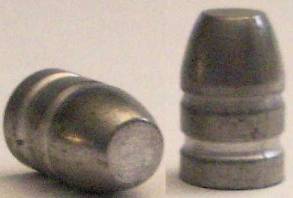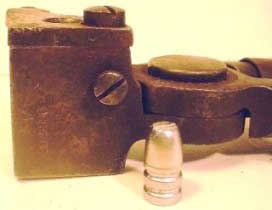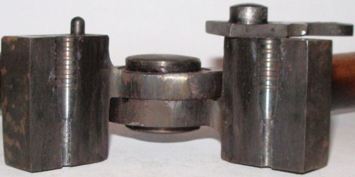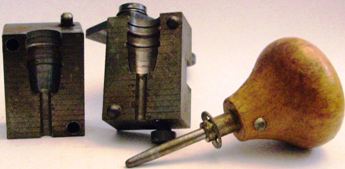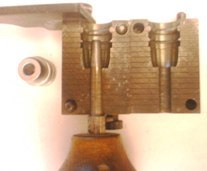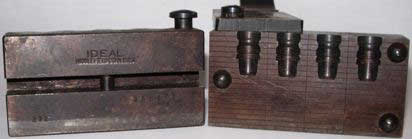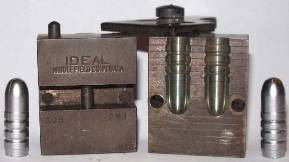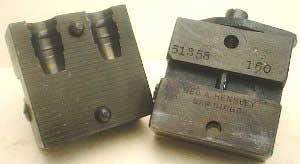|
|
|||||||||||||||||||||||||
|
Appendix A |
|||||||||||||||||||||||||
|
How old is your mould? |
|||||||||||||||||||||||||
|
The Original Ideal Handbook (originally published in 1888) lists both single cavity and Armory moulds (as well as a multitude of loading tools). Obviously, an Ideal mould cannot be older than its cherry design, so that's the starting point for determining the age of any given mould (see attached plot of cherry number vs. year). There have been a handful of recycled cherry numbers (usually from old round ball numbers, but also from a few phased out designs, like paper patched bullets), making it appear that a cherry number is much older than it really is. As a result, one must be careful using this mode of analysis, and perform various "reality checks". For example, the 31141 appears to be a very old mould design, but GC's were not invented until 1906, after cherry numbers were well into the 300s, indicating that cherry #41 got recycled (the original #41 was the 30841, an adjustable cylindrical mould for making paper patched bullets). One must also ask if there were suitable guns around at the time from which to shoot the design in question; for example the 41028 and 41032 are clearly .41 caliber pistol bullets, suitable for use in the .41 Magnum. These cherry numbers would suggest adoption well before the turn of the 20th century! Recall that the only reloadable .41 caliber handguns in the early days were the .41 Long Colt and the .41 Short Colt, both of which took heel-type bullets, or seriously undersized hollow-base bullets. The .41 Magnum wasn't introduced until 1964 and Lyman was well over cherry number 500 by that point (the original #28 was the 25728, a .25 caliber round ball for gallery shooting; the original #32 was the 31032, a heel-type bullet for the .32 Swiss Ordinance, "For those who have any use for this bullet, we can furnish mould for same." states the Ideal Handbook #9, 1897). Most of the cherry numbers assigned by Lyman/Ideal were done sequentially, making this a useful exercise, but there are exceptions that one must look out for.
Another complication is the presence of gaps and discontinuities in the sequential assignment of cherry numbers. An example is found with the enigmatic Lyman 410459. The Lyman 452460, 200 grain SWC for the .45 ACP, was released in the early 1950s (cataloged in Ideal Handbook #39, 1953), and since the 410459 is the cherry number right in front of #460, one might suppose that it too came out in this timeframe. The only problem is no one was manufacturing a .41 caliber revolver suitable to shoot a .410" diameter SWC from at the time. I have not been able to find any other bullet design that was listed with cherry #459, but the 410459 was not released until 1964 , concurrent with the introduction of the .41 Magnum. If one surveys the cherries in this range, most of them were rifle designs drawn up by Guy Loverin (#'s 454, 455, 457, 462-471). Gordon Boser had cherry numbers 452 and 453. These bullets had all been issued by the mid-1950s, well before the .41 Magnum. Given the tendency of bullet designers to get "chunks" of cherry numbers (since they would commonly come in with multiple designs), it is possible that perhaps one of these gentlemen may have also had the first #459, which for whatever reason didn't make it into production. Or maybe Lyman just skipped that number for whatever reason, and then went back and used it. Cherry numbers #456 and #458 and #461 are likewise still missing... The 500 series cherry numbers were set aside for experimental designs. The most notable of these are the Harvey Prot-X-Bore zinc washer designs, but there were others, like Harvey's experimental designs using conventional GC's whose only bearing surface was the forward driving band and the GC, everything in between was lube reservoir (357511 and 357512). After perhaps as many as a couple dozen cherries in this series, Lyman then skipped to cherry numbers in the 600's (e.g the 410610 GC-SWC for the .41 Magnum, listed in the Lyman Handbook #44, 1967). As of this writing Lyman is currently producing cherry numbers approaching 680.
Initially all Ideal moulds were available in single cavity form, with fixed handles from the 1880s up through the late 1920s. Exchangeable mould blocks were first advertised in the American Rifleman in 1927, and first cataloged by Lyman/Ideal in 1931. So, if you have a fixed handle single cavity mould, these are the dates that likely bracket its production. For example, if it's for mould number 3118 (cherry #8) then that's one of the original Ideal designs and that mould could have been made as far back as the 1880s, or as recently as about 1930. Originally, the single cavity detachable mould block made by Lyman/Ideal were smooth and unvented. This practice was continued from their introduction up through the introduction of double cavity mould blocks in 1949. Vented mould blocks were introduced shortly thereafter.
Originally Ideal HP moulds had no hardware for pin retention other than friction, and Lyman didn't add the keeper pin until 1940, so all fixed handle HP mould had no keepers, and detachable block HP moulds without keepers were made between 1931 and 1940. HP blocks made with keepers and no vent lines were made during the 1940s, while vented HP mould blocks made with keepers were made after that. The move was made to using snap-rings as HP keepers in somewhere around 1990.
Armory moulds were listed in the original Ideal Handbook (1888) and were still cataloged up through Ideal Handbook #39, indicating that Armory moulds were produced from the 1880s up until the early 1950s. Double cavity mould blocks were first cataloged in 1949, and continue to be a mainstay in the Lyman product line today. In some ways, one can think of the popular double cavity moulds displacing the Armory moulds from Lyman's product line. Initially
these double cavity moulds were stamped "Ideal", but in the late 1950s this was changed over to "Lyman". Detachable 4 cavity mould blocks were introduced in 1958 first listed on the poster that came with the Handbook of Cast Bullets. The switch-over from stamping moulds "Ideal" to stamping them "Lyman"
is thought to have occurred in the 1957-8 timeframe (when they changed the stamping on the tong tools). This suggests that 4 cavity mould blocks were stamped "Ideal" for only a short period of time, while double cavity moulds were stamped "Ideal" for about a decade. 4-cavity moulds continue to be produced today.
George Hensley started making moulds in 1932, then later teamed up with James Gibbs in 1937. So a mould stamped "Geo. Hensley" was made between 1932 and 1937. Hensley & Gibbs continued production from San Diego until 1964, so H&G moulds stamped with that location were made between 1937 and 1964. After that time, they were made in Oregon. After the company was sold in the mid-1990s, the H&G mould designs were subsequently available through Cast Performance in Riverton, WY. So, how old is your mould? |
|||||||||||||||||||||||||
|
|
|||||||||||||||||||||||||
| Table of Contents | |||||||||||||||||||||||||
| Index of Additional Glen E. Fryxell Shooting Articles | |||||||||||||||||||||||||
